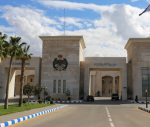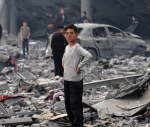You are here
What NATO's northern expansion means
Apr 25,2022 - Last updated at Apr 25,2022
STOCKHOLM — While the likely outcome of Vladimir Putin’s war against Ukraine remains unclear, Russia’s aggression has already changed the European security order in important ways. The only modern European historical comparison is Hitler’s invasion of Poland in September 1939. Both cases involved large-scale unprovoked attacks on a neighboring country with the aim of eliminating it. Hitler refused to accept the existence of an independent Poland; Putin refuses to accept the reality of an independent Ukraine.
Putin’s invasion came as a profound shock to European governments. Most European leaders had played down US warnings about an imminent attack, reasoning that although Putin can be unpredictable, he was unlikely to do anything so irrational. EU High Representative for Foreign Affairs and Security Policy Josep Borrell had received fairly rough treatment on his first visit to Moscow in early 2021; but most European governments still believed that diplomacy could produce a more stable relationship.
That illusion was shattered on February 24, which has become Europe’s 9/11: A global and geopolitical wake-up call with two main consequences. First, military spending will increase across Europe. After years of foot-dragging, almost all European NATO members have suddenly aligned with the goal of spending at least 2 per cent of GDP on defence. Europe’s largest economy, Germany, will add the equivalent of 0.5 per cent of GDP to its defense spending in just one year.
Second, NATO will be strengthened in several ways. In addition to increasing its military presence in member states adjacent to Russia, the alliance is poised to add Finland and Sweden to its ranks. Both have developed their relations with NATO since Russia’s 2014 annexation of Crimea and incursions into eastern Ukraine, but now they will take the critical step of applying for formal membership.
February 24 created an entirely new security situation for Finland and Sweden, because it demonstrated overnight that Russia is in the hands of a regime that will use military force to impose its imperial designs on Europe. Since Finland fought a war with the Soviet Union in 1939-40 and had been a part of the Russian Empire for a century before 1917, the invasion of Ukraine immediately convinced its leaders to seek NATO membership.
Finland’s own fragile arrangement with the Soviet Union, and later with Russia, was one of the main reasons why Sweden, too, stayed out of NATO. Following the accession of Norway and Denmark to the alliance in the late 1940s, Sweden pursued a Cold War policy of neutrality supported by strong defence forces.
After the collapse of the Soviet Union, Finland and Sweden joined the European Union in 1995 and gradually deepened their defence cooperation with NATO, and thus with the United States. Full NATO membership was regarded as a potential option for some later date. But although Finnish and Swedish public opinion had become slightly more receptive to the idea, majorities were still skeptical or opposed.
But February 24 tipped the balance. While there are still domestic political processes to work through, it is now virtually certain that both countries will submit applications for membership well before the NATO summit in Madrid in late June. Public opinion has changed dramatically in recent weeks. In Sweden, all major political parties, except for the former Communist Party and the dwindling Green Party, now favour membership; in Finland, all political parties from the right to the left have signalled their support. We are witnessing a political sea change, all owing to Putin’s imperial delirium.
Finland and Sweden’s accession to NATO will alter the European security architecture in two important ways. First, northern Europe will acquire the capacity to coordinate substantial defense forces regionwide. Sweden and Finland will furnish NATO with important new capabilities, as already demonstrated by the regular air force training exercises that they hold with Norway. Moreover, NATO will have a greater capacity to control the Baltic Sea, and thus to support the defence of Estonia, Latvia, and Lithuania.
Second, Swedish and Finnish membership will reinforce the European pillar within NATO. Both countries are proponents of developing the EU’s defense and security dimension, and of strengthening transatlantic ties, including the important security relationship with the United Kingdom. While NATO will remain the primary guarantor of territorial defense, the EU, with its broader policy arsenal, will become an increasingly important security alliance, and coordination between the two will deepen.
An important development to watch will be Denmark’s June 1 referendum to lift restrictions on the country’s participation in EU security and defense policies. These constraints are remnants of controversies from the early 1990s, and Denmark, along with Sweden, has already committed to increasing its defence expenditure to 2 per cent of GDP.
Taken together, these steps will substantially strengthen the entire Nordic-Baltic region’s defence potential. A stronger defense will remain crucial as long as the Kremlin remains on its current course. But northern Europeans also must take care not to provoke Russia, which has important resources and economic hubs close to Sweden and Finland. St Petersburg is Russia’s second-largest city and a major industrial zone; and the Kola Peninsula is the site of Russian submarine bases and other facilities, as well as the world’s single-largest concentration of nuclear weapons.
Russian leaders describe their imperial project as a “life or death struggle”. Taking that characterisation seriously, Finland and Sweden no longer view NATO membership as a strategic choice. Since February 24, it has become an existential imperative.
Carl Bildt is a former prime minister and foreign minister of Sweden. Copyright: Project Syndicate, 2022.














